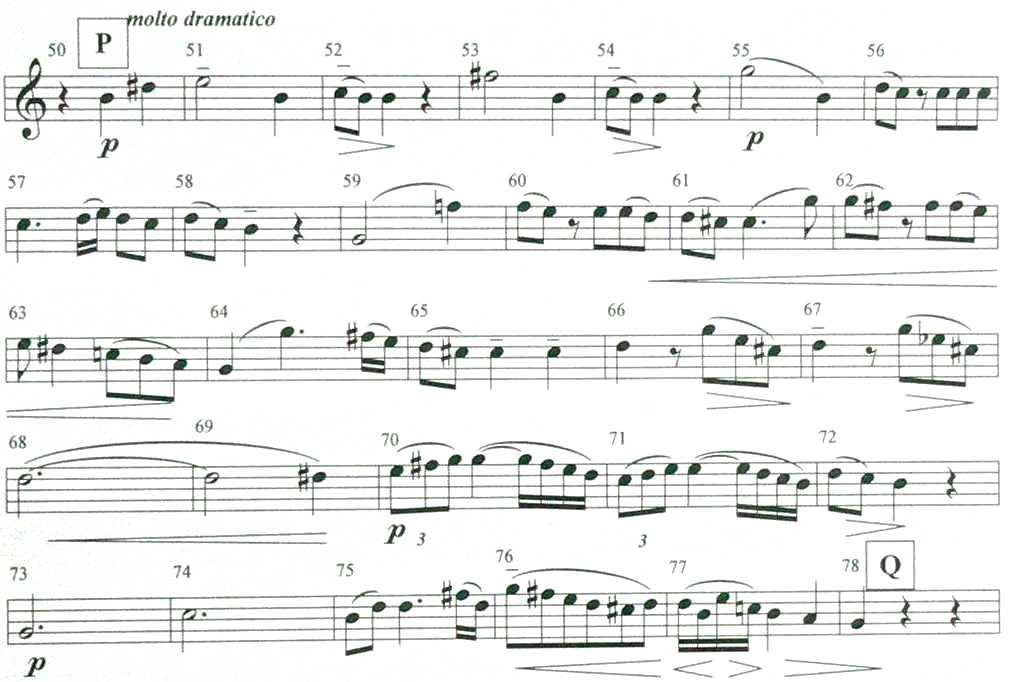|
3eme Concerto pour le Cor op.106 (K.495) |
Ein Waldhorn Konzert für den Leitgeb |
|
How to play this concert |
Interpretationsanleitung |
|
Mozart´s third Concerto for horn, which we named the No.4. Why ? The No.1 D-major is a fragment only, never finished by Mozart himself. |
Mozarts drittes Hornkonzert, das wir als no.4 bezeichnen. Warum ? No.1 in D-Dur ist ja nur ein Fragment, das Mozart nie fertiggestellt hat. |
|
2nd movement: |
ROMANZA Andante p.10 |
|
|
|
|
Now the mood changes to "molto espressivo", which could resemble "passionate" here. To do it "draengend" ( push), but not by accelerating, no, by emphasis, returning to well set legato bows keeping the tempo absolutely for MM.51-56. The thumb valve could ease some action, e.g. the entrances with e2 or f2, while all other notes stay better on the F-side. Simply, it sounds much better. Try it & listen. From M.56 on one could use more passion again. "Detache" for the upbeat to M.56 contributes to it. Do not forget the tenuto on the a1 in M.58. A nice "horn slur" from f1 to e-fl.2(F1 - T1) followed by T1-0 & again detaché for the two d2s, a round legato c2-b-nat. (M.61) and b-nat-f2 (T1), again followed by the legato f2-e2 (here as T1-F0) will involve the most lucid notes again. And here comes the wonderful horn typical octave slur f1-f2 (F1 - T1) & the two tenuto quarter notes M.65.The thumb action, staying on the first valve, will give you a certain "kick" for the up-jump f1-f2, right. One will return to the initial calmness of the movement by the two quarter notes bb1 in M.65. The eight note sequence in M.66 starts much better on T1, but use the Bbside for these initial f2s only. The modulation in M.67 should lead back to the initial mood again. If you need to breath, there is a point for extrem quick breathing after the c#2 in M.69. This is much better than losing all quality from M.71 onwards. |
Nun wechselt die Stimmung auf grossen Ausdruck, besser "leidenschaftlich", drängend aber nicht mit accelerando, also mit Ausdruck und zurückkehrend zu schönstem Legato und absolut im Zeitmass (T.51-56). Das Umschaltventil könnte manche Aktion erleichtern, z.B. die Einsätze mit es2 oder f2, während man sonst alles auf dem F-Horn spieln sollte. Es klingt einfach besser. Versuche es und höre gut zu. Ab T.56 kann man noch leidenschaftlicher werden. Das Trennen der Achtel im Auftakt zu T57 trägt dazu noch bei. Vergiss nicht das tenuto auf dem a1 in T.58. Eine hübsche Hornbindung f1 - es2 (F1-T1) gefolgt von T1-F0 (es2-d2) und die beiden getrennten d2, ein rundes legato c2-h1 (T61) und h1-f2 (T1), gefolgt von der Bindung f2-e2 (hier als T1-F0) verwenden wieder die am meisten leuchtenden Töne. Dann gibt es eine wundervolle für das Horn typische Oktavbindung f1-f2 (F1-B1) und die zwei weichen gehaltenen Viertel in T65. Die Daumenaktion (man bleibt auf dem 1.Ventil) gibt beim Aufschwung f1-f2 so richtig den Tritt in den H.... Dann kehrt man mit den zwei Viertelnoten b1 in T.65 zu der anfänglichen Ruhe des Satzes zurück. Die Achtelfolge in T66 beginnt man besser mit T1, nutze aber das B-Horn nur jeweils für die erste Note. Die Modulation in T.67 leitet zur Eingangsstimmung zurück. Wenn Du Luft holen musst, dann superschnell nach dem cis Viertel in T69. Das ist besser, als wenn die Tonqualität ab T71 nur sehr mühsam erhalten wird.
|
